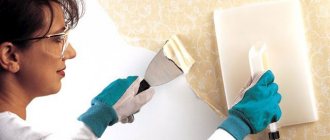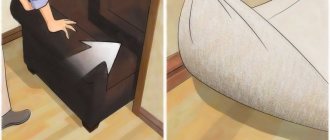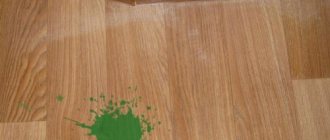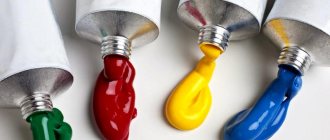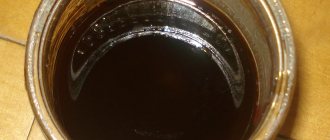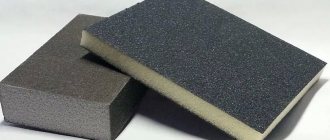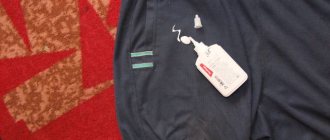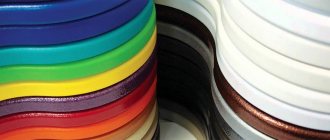The process of restoring furniture is a rather difficult task, for which several methods can be used. The restoration procedure consists of several stages. One of the most important steps is to remove the old varnish coating. Therefore, you need to figure out how to properly remove varnish from furniture without damaging the wooden surface.
Chemical method
Many people are afraid of the mechanical cleaning method only because this can ruin the surface and damage the wood. In this case, it is recommended to pay attention to the chemical method, which is also effective, so that you can easily do everything yourself. This method is perfect if you need to remove old coating from an uneven, grooved or carved surface.
Today there are many special products called washes. It can be liquid, powder or gel. The liquid is perfect if the product has a maximum of three layers of varnish. Gels are suitable for multi-layer coatings. And nail polish remover in powder form is ideal for large surfaces.
If you choose powder as a nail polish remover, it is recommended to dilute it a little with water before use. It will be easier to apply a thick paste evenly onto the surface, and this way the product will cope with its task more effectively.
The general algorithm for working with chemicals includes the following steps:
- Before you start work, put on gloves and a respirator to reliably protect yourself. Remember that you are not dealing with harsh chemicals. Otherwise, the preparation process is similar to that recommended when using the mechanical method.
- Using a regular paint brush, apply the washing liquid evenly to the prepared surface in an even layer. It only needs to be applied in one layer, and then the product should be covered with film. After a couple of hours you can open it. If there are more than three or four layers of varnish, then the product must be left under the film for four hours or more.
- After the film is removed, you need to carefully remove the layers of varnish using a regular spatula. Try not to work with pressure and do not use a spatula that is too sharp, otherwise the wood surface will be seriously damaged.
- Next, you can wash off the remaining varnish with plain water. In order to clean the surface, you can add a little table vinegar to the water. Use only one tablespoon of vinegar essence per liter of water. After this, the product will be ready for you to cover it with a new layer of special varnish.
- If the method described above did not help to completely get rid of all layers of the old coating, it is worth repeating the procedure. If only small areas of old varnish remain on the surface of the furniture, they can be easily removed with sandpaper.
If using a powder or aerosol, follow the same instructions.
Heat treatment
The essence of this process is to heat the wooden surface, due to which the varnish adheres less firmly to the surface. In other words, the varnish begins to crack, after which it can be pryed off with a tool (a chisel or spatula will do) and slowly removed.
Please pay attention to the following nuances:
- During work, you need to use protective equipment (gloves and goggles), and also ventilate the room. The fact is that when heated, the varnish releases toxic substances, and when the material is mechanically separated, pieces can bounce off of it. Also, do not forget about fire safety.
- If the varnish is heated up, but does not peel off, but becomes charred, you need to change the cleaning method and you cannot do without chemicals.
Required tools:
- Gasoline or gas burner. Such devices are quite inexpensive. However, the burner must be used with extreme caution, as the work will be carried out with an open flame.
Care must be taken when working with the burner - Construction hairdryer. The device is similar to a household hair dryer, but has significantly greater temperature capabilities, heating up to 600 degrees.
Note! A standard household hair dryer is not suitable for removing nail polish.
The main advantage of the thermal method is its high speed. However, we must not forget about the danger of overheating the varnished surface, since in this case it may catch fire.
The work is done with both hands: one holds the hairdryer, which heats the surface, and the second holds a spatula for removing nail polish.
Chemicals
The use of chemicals (removers) is a very popular method of removing varnish from furniture, doors and other wood products. It is especially suitable if the surface is delicate. You can use ordinary solvents, special liquids, gels, and powders.
The choice of the appropriate option depends on the specific situation. Denatured alcohol is suitable if you need to remove shellac.
If there are relatively few layers of varnish on the surface (up to 3), liquids can be used. Such products are not absorbed very deeply, because they erode quite quickly.
A great option for large-scale work is powders. Powdered products are easy to transport and can be stored for a long time. They should be diluted with water before use. This produces a thick paste-like mass that is convenient to apply to the surface. Various ready-made pastes and gels are also suitable for situations where significant amounts of paint material need to be removed.
You can also use spray cans to remove varnish from wood. A foam layer appears on the treated base. Such tools are convenient to use, but they are only suitable in cases where the amount of work is insignificant.
How to varnish interior wooden doors in a house?
Before you paint a wooden door with stain and varnish, you need to select the material. On the market you can find many types of products that differ in their basis:
- alkyds have a yellowish tint. The main component is the solvent. Among the advantages are strength, water resistance and quick drying (less than a day). The disadvantages include an unpleasant odor when painting and fading in the sun;
- nitro varnishes are colorless and retain the natural color of the wood. The main components are acetone and nitrogen compounds. The advantages include low cost, durability and strength. Disadvantages are flammability and toxic substances;
- polyurethane ones darken the color of the wood. The main components are polymers with long molecules. The advantages are low toxicity and absence of unpleasant odor. Among the disadvantages, the need for a brightening primer should be highlighted;
- acrylic ones are made on a water basis. Used to restore things in residential areas. The advantages are resistance to ultraviolet radiation and does not crack during use. The disadvantages are long drying time and low abrasion resistance.
How to remove varnish from furniture at home?
The process of restoring furniture is a rather difficult task, for which several methods can be used.
The restoration procedure consists of several stages. One of the most important steps is to remove the old varnish coating.
Therefore, you need to figure out how to properly remove varnish from furniture without damaging the wooden surface.
Choosing a tool for removing varnish
Before you start removing paint and varnish from the wooden surface of furniture, you should stock up on the necessary tools, which will vary depending on the method you choose.
We recommend: Types and features of luminous fluorescent paints
The entire list of tools required for the procedure:
- sandpaper for sanding;
- sandpaper;
- latex gloves;
- glasses;
- special chemical composition for washing;
- respirator and mask for protection;
- brush;
- soft sponge;
- hard metal brush;
- blowtorch;
- hair dryer used in construction;
- polyethylene film.
Selecting a removal technique
Whatever method you choose to remove paintwork, you need to remove it carefully and thoroughly.
The main thing is not to damage the wooden covering itself, otherwise you will ruin the entire restoration process. After this, you should decide which method you will use to remove the varnish from the wood surface.
The main methods that are used today:
- chemical;
- mechanical;
- thermal;
- water.
Chemical method
The chemical method will allow you to effectively remove varnish from old furniture at home. To carry it out, you must wear a cotton suit, protective rubber gloves, a mask and goggles. This is necessary to protect against chemicals that contain acid. Therefore, if they come into contact with the skin, these chemicals can cause burns.
A complex of chemicals used to remove varnish from old furniture is called a remover. It is a special powder or mixture that, due to its chemical properties, can easily corrode up to ten layers of paintwork. This product can be purchased in specialized stores.
Stages of chemical nail polish remover
- Preparatory stage. At the preparatory stage, it is necessary to dilute the dry powder with the amount of water indicated in the instructions. All components of the solution should be mixed in order to obtain a paste of a homogeneous thick consistency. It is important to remember that such a paste in the form of a gel can stick even on a vertical surface.
- Wash.
This stage, which consists of applying a paste-like remover to the furniture, is one of the key ones. The mixture is best applied with a regular brush, treating the surface in a thick layer. Movements with the brush must be carried out in one direction so as not to repeatedly apply the mixture to the same area. - Applying a special film.
This stage is needed in order to enhance the washing effect. To carry it out, take a polyethylene film and cover the surface with the applied remover with it. This film should remain on the surface for at least an hour. It is best to leave it for 3 or 4 hours. The time it takes to apply the film depends on the thickness of the paint coating and the quality of the varnish itself.Upon completion of this stage, the film is removed. It must be remembered that removing the film is possible only when the color of the remover darkens and becomes dark brown. In this case, the paintwork should swell.
- Varnish removal stage. If you did everything correctly in the previous stages, then you can easily remove varnish from old furniture even at home.
To do this, you need to take a spatula and use it to carefully remove loose particles of paintwork. Next, you need to take sandpaper and walk it several times on a varnished wooden surface. This way you can remove any remaining varnish that was not removed with a spatula. In this case, it is advisable to use a spatula that has non-sharp edges.Therefore, if you are dealing with a new tool, then you need to sharpen it a little using a whetstone. Otherwise, a spatula that is too sharp may damage the wood furniture you are cleaning. Therefore, a plastic tool, which is considered less rigid, may be an excellent option.
- Washing elimination stage.
To remove residual remover from a varnished coating, take at least 0.5 liters of ordinary water and dissolve 100-150 ml of vinegar in it. Dip a sponge into the resulting solution and thoroughly rinse the surface with it. Then wipe the surface with a flannel cloth.Thoroughly cleaned furniture should be left to dry outdoors, out of direct sunlight. This step must be carried out quickly so that the wooden surface is not exposed to excessive moisture.
Mechanical methods
There are several options for removing varnish from old furniture mechanically. Therefore, it is better to study each of these options and choose the appropriate option for yourself.
First option
This method is best chosen if the paintwork material peels off in fragments. To perform this technique, use coarse sandpaper or a steel brush. With these tools you need to clean the surface using circular movements. Next, you need to take a screwdriver or spatula, with which you can remove the varnish even in hard-to-reach areas.
Second option
This technique is more effective and is used if the varnish coating has not yet begun to peel off. Here you will need an eccentric sander and hard sandpaper.
Before carrying out work, wear safety glasses and a mask. Next, using a machine filled with sandpaper with a grit of 80 to 120, you should carefully treat the surface as a whole. After this, the machine changes the previous version of sandpaper to 180-grit material.
This tool should also be used to go over varnished wood. At the final stage, you should make sure that no fragments of varnish remain on the furniture.
In general, mechanical methods are recommended if you plan to apply enamel or other paint coating to wooden furniture after removing the varnish. This is due to the fact that mechanical processing can damage the wood.
Thermal method
If you plan to remove the varnish using the thermal method, then for this you will need a hair dryer or a blowtorch. The main advantages of the thermal method of removing varnish are the speed of work and high quality of cleaning. However, to get good results, you will need to follow all the rules for performing this technique.
We recommend: Varnish for plywood: secrets of selection, application and pre-treatment of wood material
At the first stage, it is necessary to heat a certain fragment of the wooden surface from which you plan to remove the varnish. This should be done using a hair dryer or blowtorch. After this, using a spatula or a sharp knife, carefully remove the melted layer of paintwork.
It is advisable to work as quickly as possible so that the varnish does not have time to harden again. After removing the coating from one area, they move on to removing the varnish from the next fragment. This is how the varnish coating is gradually removed from the entire surface of the furniture.
The thermal technique requires special care. To do this, you must strictly observe a certain firing distance and not violate the temperature regime. This will prevent the wood from turning black.
If you do not follow all the rules, the wooden covering may become unusable. Therefore, if smoke or bubbles appear, you should immediately stop and remove the tool from the wooden surface.
Water method
The water method of removing nail polish is the safest and easiest. The main tool here is a sponge, which needs to be well moistened with water. Next, use a sponge to wipe the surface that you plan to clean from varnish. Liquid that gets on the paintwork will gradually dissolve it.
The heavily moistened surface must be walked over with coarse sandpaper many times. These steps must be repeated until the paint material becomes a paste. After complete removal of the varnish, the wooden furniture is thoroughly washed and dried. At the final stage, the surface is treated with fine-grained sanding paper.
Thus, removing paint and varnish from old wooden furniture can be done using several methods. Moreover, in each specific situation you need to choose the most optimal method of removing varnish.
Advantages and features of using varnish
We coat the door with varnish
In addition to the fact that varnish allows you to give the door a spectacular look, it also has a huge number of protective functions that are so necessary for the door leaf. Thanks to various types of varnish, you can completely change the appearance of the solid wood and give ordinary pine the appearance of a valuable type of wood. Varnishing also allows you to emphasize the shade that the door leaf has and give some of its details a deep and rich color.
Important! Many people confuse the concepts of impregnations for wooden surfaces and protective coatings. If the former serve to protect the material from mold and rot, then the latter protect the wood from the external negative effects of water, sun and sudden temperature changes.
For myself, I found out the following advantages that allow you to varnish the door yourself:
- Varnish is an affordable material - everyone can choose the appropriate mixture based on the pricing policy. But here we should not forget that only a high-quality mixture can improve the protective and external properties of the door and at the same time extend its service life. Therefore, such protection will not cost a penny.
- Simple application - even a beginner who has no previous experience in carrying out such events can coat surfaces with varnish
- Versatility - the material is used for various surfaces, in addition, it can be used as a fixing for decoupage and painting
- The protective functions that varnish has increase the resistance of a wooden door to various negative influences. This can include mechanical damage, scratches, moisture and ultraviolet light.
As it turns out, there are plenty of varieties of varnish, but they are all divided by composition. There are such as:
- Oil varnish - as is already clear, the main component is oils, which, when absorbed into the surface, can change its color. They can be used as a solvent, they take a long time to dry and most often have an unpleasant odor
- Water-based - popular nowadays because they are colorless, have no strong odors and can be either completely matte or glossy. Has a short drying time, but the door leaf requires preliminary application of stain
Remove varnish from furniture by sanding
Using sanding, you can not only remove varnish, but also level the surface of wooden furniture. Sanding is done with sandpaper (abrasive) paper manually or using a sanding machine.
To make hand sanding easier, use a simple wooden block and wrap a piece of sandpaper around it.
To remove varnish from furniture , start sanding the surface with medium-grain paper, gradually moving to fine-grain paper.
A special sanding machine of small size and power will greatly simplify the removal of varnish. For such a machine, only fabric-based sandpaper is suitable.
After each sanding step, remove dust from the surface of the object with a slightly damp cotton cloth.
Before removing varnish from furniture , buy a special device with a grip for sandpaper at a hardware store. This will allow you to distribute the sanding pressure evenly.
To sand rounded and convex surfaces, move the sandpaper strip up and down at right angles.
How and how to remove paint from a wooden surface
It is very difficult to completely remove old paint from the surface of furniture, but we will try. For this, special chemical solvents are most often used, which can be purchased at construction or specialized stores, as well as construction hair dryers.
Gently wash the surface of the product with a dishwashing sponge. Instead of a sponge, you can use foam rubber or cotton cloth. Remove soap solution and dirt from the surface of the furniture by wiping it with a soft cotton cloth, first slightly damp, then dry.
First, let's look at how to remove paint from furniture using a solvent and a metal spatula:
- Apply solvent with a synthetic flute brush. Sometimes it is necessary to apply several layers of solvent to remove a thick layer of paint. Follow the time recommended by the manufacturer.
- When the paint softens and begins to peel off the surface of the wood, scrape it off with a metal putty knife.
- Depending on the composition of the old paint and the number of layers, it may be necessary to reapply the solvent to achieve greater softening and swelling of the paint.
How to properly coat an old wooden door with stain or varnish?
First you need to mix the product in an open jar with calm movements. Then pour into the tray. To renew the surface, use brushes or rollers. Apply the product to the canvas using smooth and quick movements.
It is necessary to cover the entire canvas without interruptions or delays. The next layer is applied perpendicular to the previous one. If you decide to open it in three layers, then the direction of the third should be the same as the first. After each applied layer, wait until it dries completely. The amount of time is indicated on the packaging.
A narrow brush is used to cover the paneled part. To update the frame and trim, you need to paint them in a vertical position. If drips form, you need to use sanding paper.
To paint a piece of wood, you need to remove the fittings from it so that the impregnation can get into all hidden areas of the structure. If this is not done, rot may form or a bark beetle may infest.
We hide cracks and restore chips
At the dacha of our forum member AnnaSava there is a beautiful oak sideboard with carved glass from the early 20th century. The wooden top was perfectly preserved, but the corners of the lower doors were chewed by rats. Is it possible to restore the lost surface on your own? Participant FORUMHOUSELali suggests the following solution - mix sawdust with epoxy resin and “build up” the missing corners if the sideboard is intended for painting in the future.
You can also eliminate defects on not very valuable pieces of furniture using modern wood putties. If there are chips of wood or minor damage to the veneer on antique furniture, it is better to restore them using bone or fish glue mixed with sawdust (from sanding). Bone glue is made from animal bones, fish glue - from the swim bladder of sturgeon fish - ready-made compositions today can be easily found in construction or online stores.
How to restore a varnished interior wooden door?
In order to renew the surface of wood, you can use the following methods:
- Paint the canvas. A wide range of colors allows you to choose the desired shade. You can choose a plain color option or paint the canvas with a specific pattern. The materials differ not only in color, but also in composition. After painting, the surface is covered with a layer of varnish.
- Self-adhesive film and wallpaper.
- Laminate. Ideal option to hide wood defects. You can choose any color, and the material is attached with glue.
In order not to buy new ones, you should learn how to update varnished wooden interior doors. This option will not only change the interior, but will also protect the surface of the canvas from various adverse influences.
Choosing a tool for removing varnish
Before you start removing paint and varnish from the wooden surface of furniture, you should stock up on the necessary tools, which will vary depending on the method you choose.
The entire list of tools required for the procedure:
- sandpaper for sanding;
- sandpaper;
- latex gloves;
- glasses;
- special chemical composition for washing;
- respirator and mask for protection;
- brush;
- soft sponge;
- hard metal brush;
- blowtorch;
- hair dryer used in construction;
- polyethylene film.
Sequence of work
Door finishing with varnish
As with all bases, proper surface preparation comes first. If the canvas has already been varnished, it should be removed. Such manipulations can be done in several ways:
- Using sandpaper - in order to remove the old coating, it is better to stock up on a block with which it will be more convenient to hold the sandpaper. You should start with coarse-grained pieces and then move on to fine-grained pieces
- A sanding machine will make the whole process very fast and convenient. Removing the coating with its help will not be difficult or physically expensive.
- Solvent - although this method can be called very relevant, it can ruin the wood or not work in the required volume
Important! If there are chips, use a special mastic that can be matched to the color of the canvas. If you decide to use stain before coating, apply it immediately after sanding and cleaning the surface.
From a friend of mine, I learned some features that will make covering the canvas much easier and more correct. Doors require dismantling and installation in a horizontal position - only this action will protect the door as much as possible from smudges and other flaws. Using a brush allows you to apply the varnish evenly. In total, you should apply from three to five layers - if you applied the base layer with horizontal brush movements, then apply the second one in a vertical direction. You should also alternate subsequent layers if you need to coat the canvas with varnish.
Mechanical method
The mechanical method is popular, thanks to which you can achieve excellent results and ideally prepare the surface for repair. This method has one significant advantage - the absence of any chemicals. But be prepared for the fact that the process can be long and requires special care.
To carry out mechanical removal of the old coating, you will need tools. It is quite possible to use a metal plate as a tool, which should first be sharpened. This must be done so that the tool can better cope with the task.
Sandpaper of various types can also help in this matter. A brush with metal bristles will come in handy at the very beginning of the preparatory work. You can also use a grinder or even an angle grinder, which will need to be equipped with a special attachment.
You can use a router if you have one in your home.
All of the above tools will help you cope with a small layer of varnish. When using tools such as a grinder or grinder, it is recommended to be extremely careful not to damage the structure of the product itself.
Don’t forget about personal safety methods. The work should be done with gloves, a respirator and safety glasses, since during cleaning there will be a lot of fine dust, breathing which is strictly not recommended.
Nail polish removal methods
It must be said right away that only the most popular surface cleaning methods are covered here. There is no universal recipe that is applicable in all situations.
The choice of method depends on many variables, including:
- The type of base is of considerable importance, since it makes a difference what exactly needs to be cleaned - furniture or parquet.
- Varnish composition. Different options are relevant for different compositions.
- Layer thickness. It's one thing to remove one layer, quite another to remove many old layers.
Why is it necessary to get rid of old coating?
The process of restoration of wooden objects consists of three equivalent stages:
- Preparatory, the purpose of which is to remove the old varnish coating until the wooden surface is completely exposed.
- Restorative, during which the texture of the wood is updated using special means.
- The final stage, which consists of applying the final coating to the product, according to the restoration project.
Attention! When starting to renew a wooden product, you should remember the main rule - you need to work carefully, without haste, so as not to damage the wood. It is better to perform cleaning in several passes.
Required Tools
To completely remove old varnish from wood, you will need the following set of tools:
- cellophane film;
- construction hair dryer (a regular hair dryer is not effective for drying hair);
- wire brush with hard bristles;
- brush;
- kitchen sponge;
- mask, respirator for respiratory protection;
- chemical mixture for washing off the composition;
- eye protection glasses;
- thick gloves;
- grinding and sandpaper.
